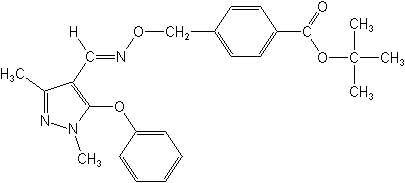Pesticides >> Insecticides >> Fenpyroximate
Fenpyroximate
Fenpyroximate 95%TC
Fenpyroximate 5%SC
Acaricide
pyrazole (acaricide)

NOMENCLATURE
Common name fenpyroximate (BSI, draft E-ISO)
IUPAC name tert-butyl (E)-a-(1,3-dimethyl-5-phenoxypyrazol-4-ylmethyleneamino-oxy)-p-toluate
Chemical Abstracts name 1,1-dimethylethyl (E)-4-[[[[(1,3-dimethyl-5-phenoxy-1H-pyrazol-4-yl)methylene]amino]oxy]methyl]benzoate
CAS RN [134098-61-6]; [111812-58-9] unspecified stereochemistry
Development codes NNI-850 (Nihon Nohyaku); HOE 555-02A (Hoechst)
APPLICATIONS
Biochemistry Inhibitor of mitochondrial electron transport at complex
I. Mode of action Quick knockdown activity against larvae, nymphs
and adults, mainly by contact and ingestion. Also some moulting
inhibitory activity on nymphs. Uses Control of important phytophagous
mites. Effective against Tetranychidae (spider mites), Tarsonemidae,
Tenuipalpidae (false spider mites) and Eriophyidae in citrus, apple,
pear, peach, grapes, etc. Phytotoxicity Not phytotoxic to top fruit,
citrus, tea, vegetables and ornamentals. Formulation types SC. Selected
tradenames: 'Danitoron' (Japan) (Nihon Nohyaku); 'Danitron' (Nihon
Nohyaku); 'Ortus' (Nihon Nohyaku); 'Pamanrin' (China) (Nihon Nohyaku)
Fenpyroximate OTHER TRADENAMES
'Akari' (Nihon Nohyaku); 'Kiron' (Nihon Nohyaku); 'Manhao' (Taiwan)
(Nihon Nohyaku); 'Acaban' (Syngenta); 'Acaritan' (Aventis); 'Asalto'
(Syngenta); 'Dynamite' (Syngenta); 'Kendo' (Aventis); 'Meteor' (Syngenta);
'Miro' (Aventis); 'Naja' (Syngenta); 'Salbiwang' (Hannong); 'Sequel'
(Aventis); 'Terror' (Calliope)
ANALYSIS
Product analysis by hplc; residues in soil by glc, in water by hplc,
in plants by glc/hplc.
MAMMALIAN TOXICOLOGY
Reviews FAO/WHO 74, 76 (see part 2 of the Bibliography). See also
J. Pestic. Sci., 17, S261-267 (1992). Oral Acute oral LD50 for male
rats 480, female rats 245 mg/kg. Skin and eye Acute percutaneous
LD50 for male and female rats >2000 mg/kg. Non-irritating to
skin; slightly irritating to eyes (rabbits). Inhalation LC50 (4
h) for male rats 0.33, female rats 0.36 mg/l. NOEL for male rats
0.97, female rats 1.21 mg/kg b.w. ADI (JMPR) 0.01 mg/kg b.w. [1995].
Other Not carcinogenic, teratogenic or mutagenic in long-term studies.
Toxicity class WHO (a.i.) II
Fenpyroximate: ECOTOXICOLOGY
Birds LD50 for bobwhite quail and mallard ducks >2000 mg tech./kg.
Dietary LD50 (8 d) for bobwhite quail and mallard ducks >5000
ppm. Fish LC50 (48 h) for carp 0.006 mg/l. Daphnia LC50 (3 h) 0.085
mg/l. Bees No adverse effect on honeybees at 250 ppm (5 ´
recommended dose). Other beneficial spp. Relatively non-toxic to
predacious mites. Little adverse effect at 25-50 ppm on Chrysopa
nipponensis, Harmonia axyridis, Ephedrus japonicus, Misumenops tricuspidatus,
Lycosa pseudoannulata, Orius sp., Scolothrips sp.
Fenpyroximate: ENVIRONMENTAL FATE
Soil/Environment DT50 26.3-49.7 d (J. Pestic. Sci., 18, 67-75 (1993)).